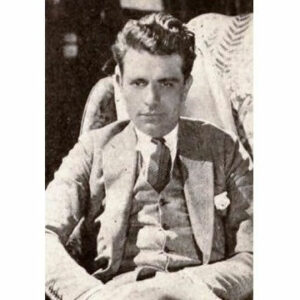Wesley Ruggles was an American film director who is most remembered for the classic Western film “Cimarron.” While his reputation grew as a result of the film, he did not have an easy time achieving success. He had already created roughly 50 pictures before creating ‘Cimarron,’ the majority of which were forgettable and forgotten soon after their release. His career took off after the success of ‘Cimarron,’ and he went on to make several other famous pictures, including ‘No Man of Her Own’ and ‘I’m No Angel.’ Wesley was born in Los Angeles and had an early interest in cinema, which was still in its infancy when he was growing up in the early twentieth century. His brother, Charles, was also a cinema buff, and the two brothers ventured into this exciting new form of entertainment that was gaining traction in America. Wesley started his acting career as a child, appearing in a number of silent films, occasionally alongside Charlie Chaplin. He soon moved on to directing, which he found more intriguing than performing. His early years as a director were difficult; despite completing multiple pictures, he did not have much success for a long period. He rose to prominence after directing the lavish Western hit ‘Cimarron,’ which established him as a respected director.
Childhood and Adolescence
Wesley Ruggles was born in Los Angeles, California, on June 11, 1889. He was Charles Ruggles’ younger brother, who went on to become a famous Hollywood figure in the future. He was born and raised in San Francisco, where he also attended university. He began an apprenticeship in stock and musical comedy at a young age, having always been interested in performing.
Career of Wesley
Wesley Ruggles made his acting debut in the 1915 comedy short ‘Caught in a Park,’ as a Keystone Kop. He performed in a series of short films with comic Charlie Chaplin during the next few years, including ‘The Bank’ (1915) and ‘Police’ (1916). (1916). By 1917, he had shifted his concentration to directing, and he began his career as a filmmaker with a series of short films. He worked as a camera operator in the Army Signal Corps in the late 1910s, as World War I was drawing to a close. In 1919, he directed his first feature picture, a criminal drama called “The Winchester Woman.” ‘The Leopard Woman’ (1920), ‘The Remittance Woman’ (1923), and ‘The Age of Innocence’ (1924), the first screen version of Edith Wharton’s work, are among his other early films.
He was a prolific director who directed films such as “Finders Keepers” (1928), “The Fourflusher” (1928), and “Port of Dreams” (1929). He released the Laura La Plante film ‘Scandal’ (1929), which had some spoken dialogue, after the talkies became popular. He was not successful despite being a proactive director. The majority of the films he directed were mediocre and were forgotten soon after their release, failing to impress reviewers or audiences. He made many melodramas starring Ethel Clayton while trying to establish his career, but none of them did well.
In 1931, his fortunes improved when he directed the Western film ‘Cimarron,’ which was based on Edna Ferber’s eponymous novel.
The epic picture, which covered 40 years from 1889 to 1929, was a critical hit and brought Ruggles the acclaim he deserved. ‘No Man of Her Own’ (1932) with Clark Gable and Carole Lombard, ‘I’m No Angel’ (1933) with Mae West and Cary Grant, ‘College Humor’ (1933) with Bing Crosby, and ‘Bolero’ (1934) with George Raft and Carole Lombard were among the comedies he directed during the next few years. Though he had a lot of success in the early 1930s, his career started to fall apart after that. ‘The Bride Comes Home’ (1935), ‘I Met Him in Paris’ (1937), ‘True Confession’ (1937), and ‘Sing, You Sinners’ (1937) were some of the films he filmed in the late 1930s (1938).
During the 1940s, his career was on the fall due to the failure of none of his pictures at the box office. He produced and directed ‘London Town’ in 1946 after directing pictures such as ‘Somewhere I’ll Find You’ (1942), ‘Slightly Dangerous’ (1943), and ‘See Here, Private Hargrove’ (1944). The picture was a critical and commercial flop, and it was Ruggles’ final project.
Major Projects of Wesley
Wesley Ruggles is best known for directing Richard Dix and Irene Dunne in the Western film “Cimarron.” It was an expensive production, costing $1.4 million to make in 1931. The film received positive reviews and was the first to get more than six Academy Award nominations, with three wins. He was particularly well-known for his romantic drama ‘No Man of Her Own,’ in which Clark Gable and Carole Lombard played a married couple in their one and only picture together.
Achievements & Awards
Wesley Ruggles received an Academy Award nomination for Best Director for the film “Cimarron,” which received more than six nominations and won the Best Picture Award.
Personal History and Legacy
Wesley Ruggles was married four times, three of which resulted in divorce. Kathryn Crawford, Virginia Caldwell, and Arline Judge were his previous wives. In 1940, he married Marcelle Rogez for the fourth and final time, and they were married for more than three decades until his death. On January 8, 1972, he died as a result of a stroke.
Estimated Net Worth
Cha Tae-hyun is one of the wealthiest and most popular actors in Hollywood. Cha Tae-net hyun’s worth is estimated to be at $1.5 million, according to Wikipedia, Forbes, and Business Insider.


